The Cleansing of the Gundica Temple
Sri Caitanya Mahaprabhu washed and cleansed the Gundica temple with His devotees and associates. In this way He made the temple as cool and bright as His own heart, and thus He made the place befitting for Lord Sri Krsna to sit.
The Gundica temple is situated two miles northeast of the Jagannatha temple. At the time of the Ratha-yatra festival, Lord Jagannatha goes to the Gundica temple from His original temple and stays there for one week. After one week, He returns to His original temple. It is understood by hearsay that the wife of Indradyumna, the King who established the Jagannatha temple, was known as Gundica.
Sri Caitanya Mahaprabhu washed the Gundica temple before the Ratha-yatra took place. He then took His bath at Indradyumna Lake and partook of prasada in the garden nearby. While Sri Caitanya Mahaprabhu washed the temple of Gundica, a Gaudiya Vaisnava washed the lotus feet of the Lord and drank the water. This incident is very significant, for it awoke within the devotee ecstatic love.
Sri Caitanya Mahaprabhu washed and cleansed the Gundica temple with His devotees and associates. In this way He made the temple as cool and bright as His own heart, and thus He made the place befitting for Lord Sri Krsna to sit.
All glories to Gauracandra! All glories to Nityananda! All glories to Advaitacandra! And all glories to the devotees of Lord Sri Caitanya Mahaprabhu! All glories to the devotees of Lord Sri Caitanya Mahaprabhu, headed by Srivasa Thakura!
I beg their power so that I can properly describe Sri Caitanya Mahaprabhu.
The Lord passed some days in great jubilation. Then the car festival of Lord Jagannatha approached. Sri Caitanya Mahaprabhu first of all called for Kasi Misra, then for the superintendent of the temple, then for Sarvabhauma Bhattacarya. When these three people came before the Lord, He begged them for permission to wash the temple known as Gundica.
Upon hearing the Lord’s request for them to wash the Gundica temple, the padicha, the superintendent of the temple, said, “My dear sir, we are all Your servants. Whatever You desire is our duty to perform. The King gave a special order for me to do without delay whatever Your Lordship orders. My dear Lord, washing the temple is not service befitting You. Nonetheless, if You wish to do so, it is to be accepted as one of Your pastimes. To wash the temple, You need many waterpots and brooms. Therefore order me. I can immediately bring all these things to You.” As soon as the superintendent understood the desire of the Lord, he immediately delivered a hundred new waterpots and a hundred brooms for sweeping the temple.
The next day, early in the morning, the Lord took His personal associates with Him and, with His own hand, smeared sandalwood pulp on their bodies. He then gave each devotee a broom with His own hand, and taking all of them personally with Him, the Lord went to Gundica. In this way the Lord and His associates went to cleanse the Gundica temple. At first they cleansed the temple with the brooms.
The Lord cleansed everything inside the temple very nicely, including the ceiling. He then took up the sitting place [simhasana], cleansed it and again put it in its original place. Thus the Lord and His companions cleansed and swept all the temple’s buildings, big and small, and finally cleansed the area between the temple and the kirtana hall. Indeed, hundreds of devotees were engaged in cleansing all around the temple, and Sri Caitanya Mahaprabhu was personally carrying out the operation just to instruct others.
Sri Caitanya Mahaprabhu washed and cleansed the temple in great jubilation, chanting the holy name of Lord Krsna all the time. Similarly, all the devotees were also chanting and at the same time performing their respective duties. The entire beautiful body of the Lord was covered with dust and dirt.
In this way it became transcendentally beautiful. At times, when cleansing the temple, the Lord shed tears, and in some places He even cleansed with those tears. After this, the place where the Deity’s food was kept [bhoga-mandira] was cleansed. Then the yard was cleansed, and then all the residential quarters, one after the other.
After Sri Caitanya Mahaprabhu collected all the straw, dust and grains of sand in one place, He gathered it all in His cloth and threw it outside. Following the example of Sri Caitanya Mahaprabhu, all the devotees, in great jubilation, began to gather straws and dust with their own cloths and throw them outside the temple. The Lord then told the devotees, “I can tell how much you have labored and how well you have cleansed the temple simply by seeing all the straw and dust you have collected outside.” Even though all the devotees collected dirt in one pile, the dirt collected by Sri Caitanya Mahaprabhu was much greater.
After the inside of the temple was cleansed, the Lord again allotted areas for the devotees to cleanse. The Lord then ordered everyone to cleanse the inside of the temple very perfectly by taking finer dust, straws and grains of sand and throwing them outside. After Sri Caitanya Mahaprabhu and all the Vaisnavas cleansed the temple for the second time, Sri Caitanya Mahaprabhu was very happy to see the cleansing work.
While the temple was being swept, about a hundred men stood ready with filled waterpots, and they simply awaited the Lord’s order to throw the water from them. As soon as Sri Caitanya Mahaprabhu called for water, all the men immediately brought the hundred waterpots, which were completely filled, and delivered them before the Lord.
In this way, Sri Caitanya Mahaprabhu first washed the main temple and then thoroughly washed the ceiling, the walls, the floor, the sitting place [simhasana] and everything else within the room.
Sri Caitanya Mahaprabhu Himself and His devotees began to throw water onto the ceiling. When this water fell, it washed the walls and floor. Then Sri Caitanya Mahaprabhu began to wash the sitting place of Lord Jagannatha with His own hands, and all the devotees began to bring water to the Lord. All the devotees within the temple began to wash. Each one had a broom in his hand, and in this way they cleansed the temple of the Lord.
Someone brought water to pour into the hands of Sri Caitanya Mahaprabhu, and someone poured water on His lotus feet. The water that fell from the lotus feet of Sri Caitanya Mahaprabhu was drunk by someone who hid himself. Someone else begged for that water, and another person was giving that water in charity.
After the room was washed, the water was let out through an outlet, and it then flowed and filled the yard outside. The Lord mopped the rooms with His own clothes, and He polished the throne with them also. In this way all the rooms were cleansed with a hundred waterpots. After the rooms had been cleansed, the minds of the devotees were as clean as the rooms. When the temple was cleansed, it was purified, cool and pleasing, just as if the Lord’s own pure mind had appeared.
Since hundreds of men were engaged in bringing water from the lake, there was no place to stand on the banks. Consequently someone began to draw water from a well. Hundreds of devotees brought water in the pots, and hundreds took the empty pots away to fill them up again. With the exception of Nityananda Prabhu, Advaita Acarya, Svarupa Damodara, Brahmananda Bharati and Paramananda Puri, everyone was engaged in filling the waterpots and bringing them there. Many of the waterpots were broken when people collided with one another, and hundreds of men had to bring new waterpots to fill. Some people were filling the pots, and others were washing the rooms, but everyone was engaged in chanting the holy name of Krsna and Hari. One person begged for a waterpot by chanting the holy names “Krsna, Krsna,” and another delivered a pot while chanting “Krsna, Krsna.” Whenever anyone had to speak, he did so by uttering the holy name of Krsna. Consequently, the holy name of Krsna became an indication for everyone who wanted something.
As Sri Caitanya Mahaprabhu was vibrating the holy name of Krsna in ecstatic love, He Himself was performing the work of hundreds of men. It appeared as though Sri Caitanya Mahaprabhu were cleansing and washing with a hundred hands. He approached every devotee just to teach him how to work. When He saw someone doing nicely, the Lord praised him, but if He saw that someone was not working to His satisfaction, He immediately chastised that person, not bearing him any grudge. The Lord would say, “You have done well. Please teach this to others so that they may act in the same way.” As soon as they heard Sri Caitanya Mahaprabhu say this, everyone became ashamed. Thus the devotees began to work with great attention. They washed the Jagamohana area and then the place where food was kept. All other places were also washed. In this way the meeting place was washed, the entire yard, the raised sitting places, the kitchen and every other room. Thus all places around the temple were thoroughly washed within and without.
After everything was thoroughly washed, a Vaisnava from Bengal, who was very intelligent and simple, came and poured water on the lotus feet of the Lord. The Gaudiya Vaisnava then took that water and drank it himself. Seeing that, Sri Caitanya Mahaprabhu felt a little unhappy and was also outwardly angry. Although the Lord was certainly satisfied with him, He became angry externally in order to establish the etiquette of religious principles. The Lord then called for Svarupa Damodara and told him, “Just see the behavior of your Bengali Vaisnava. “This person from Bengal has washed My feet within the temple of the Personality of Godhead. Not only that, but he has drunk the water himself. “I now do not know what My destination is because of this offense. Indeed, your Bengali Vaisnava has greatly implicated Me.” At this point Svarupa Damodara Gosvami caught the Gaudiya Vaisnava by the neck and, giving him a little push, ejected him from the Gundica Puri temple and made him stay outside. After Svarupa Damodara Gosvami returned within the temple, he requested Sri Caitanya Mahaprabhu to excuse that innocent person.
After this incident, Sri Caitanya Mahaprabhu was very much satisfied. He then asked all of the devotees to sit down in two lines on both sides. The Lord then personally sat down in the middle and picked up all kinds of straw, grains of sand and dirty things. While Sri Caitanya Mahaprabhu was picking up the straws and grains of sand, He said, “I shall gather everyone’s collection, and I shall ask whoever has collected less than all the others to pay a fine of sweet cakes and sweet rice.” In this way all the quarters of the Gundica temple were completely cleansed and cleared. All quarters were cool and spotless, like one’s cleansed and pacified mind.
When the water from the different rooms was finally let out through the halls, it appeared as if new rivers were rushing out to meet the waters of the ocean. Outside the gateway of the temple, all the roads were also cleansed, and no one could tell exactly how this was done.
In commenting on the cleansing of the Gundica temple, Srila Bhaktisiddhanta Sarasvati Thakura says that Sri Caitanya Mahaprabhu, as the world leader, was personally giving instructions on how one should receive Lord Krsna, the Supreme Personality of Godhead, within one’s cleansed and pacified heart. If one wants to see Krsna seated in his heart, he must first cleanse the heart, as prescribed by Sri Caitanya Mahaprabhu in His Siksastaka: ceto-darpana-marjanam. In this age, everyone’s heart is especially unclean, as confirmed in Srimad-Bhagavatam: hrdy antah-stho hy abhadrani. To wash away all dirty things accumulated within the heart, Sri Caitanya Mahaprabhu advised everyone to chant the Hare Krsna mantra. The first result will be that the heart is cleansed (ceto-darpana-marjanam). Similarly, Srimad-Bhagavatam (1.2.17) confirms this statement:
srnvatam sva-kathah krsnah
punya-sravana-kirtanah
hrdy antah-stho hy abhadrani
vidhunoti suhrt satam
“Sri Krsna, the Personality of Godhead, who is the Paramatma [Supersoul] in everyone’s heart and the benefactor of the truthful devotee, cleanses desire for material enjoyment from the heart of the devotee who relishes His messages, which are in themselves virtuous when properly heard and chanted.”
If a devotee at all wants to cleanse his heart, he must chant and hear the glories of the Lord, Sri Krsna (srnvatam sva-kathah krsnah). This is a simple process. Krsna Himself will help cleanse the heart because He is already seated there. Krsna wants to continue living within the heart, and the Lord wants to give directions, but one has to keep his heart as clean as Lord Caitanya Mahaprabhu kept the Gundica temple. The devotee therefore has to cleanse his heart just as the Lord cleansed the Gundica temple. In this way one can be pacified and enriched in devotional service. If the heart is filled with straw, grains of sand, weeds or dust (in other words, anyabhilasa-purna), one cannot enthrone the Supreme Personality of Godhead there. The heart must be cleansed of all material motives brought about through fruitive work, speculative knowledge, the mystic yoga system and so many other forms of so-called meditation. The heart must be cleansed without ulterior motive. As Srila Rupa Gosvami says: anyabhilasita-sunyam jnana-karmady-anavrtam. In other words, there should not be any external motive. One should not attempt material upliftment, understanding the Supreme by speculative knowledge, fruitive activity, severe austerity and penance, and so on. All these activities are against the natural growth of spontaneous love of Godhead. As soon as these are present within the heart, the heart should be understood to be unclean and therefore unfit to serve as Krsna’s sitting place. We cannot perceive the Lord’s presence in our hearts unless our hearts are cleansed.
A material desire is explained as a desire to enjoy the material world to its fullest extent. In modern language, this is called economic development. An inordinate desire for economic development is considered to be like straws and grains of sand within the heart. If one is overly engaged in material activity, the heart will always remain disturbed. As stated by Narottama dasa Thakura:
samsara visanale, diva-nisi hiya jvale,
judaite na kainu upaya
In other words, endeavor for material opulence is against the principle of devotional service. Material enjoyment includes activities such as great sacrifices for auspicious activity, charity, austerity, elevation to the higher planetary system, and even living happily within the material world.
Modernized material benefits are like the dust of material contamination. When this dust is agitated by the whirlwind of fruitive activity, it overcomes the heart. Thus the mirror of the heart is covered with dust. There are many desires for performing auspicious and inauspicious activities, but people do not know how life after life they are keeping their hearts unclean. One who cannot give up the desire for fruitive activity is understood to be covered by the dust of material contamination. Karmis generally think that the interaction of fruitive activities can be counteracted by another karma, or fruitive activity. This is certainly a mistaken conception. If one is deluded by such a conception, he is cheated by his own activity. Such activities have been compared to an elephant’s bathing. An elephant may bathe very thoroughly, but as soon as it comes out of the river, it immediately takes some sand from the land and throws it all over its body. If one suffers due to his past fruitive activities, he cannot counteract his suffering by performing auspicious activities. The sufferings of human society cannot be counteracted by material plans. The only way suffering can be mitigated is by Krsna consciousness. When one takes to Krsna consciousness and engages himself in the devotional service of the Lord–beginning with chanting and hearing the glories of the Lord–the cleansing of the heart begins. When the heart is actually cleansed, one can clearly see the Lord sitting there without any disturbance. In Srimad-Bhagavatam (9.4.68) the Lord confirms that He sits within the heart of the pure devotee: sadhavo hrdayam mahyam sadhunam hrdayam tv aham.
Impersonal speculation, monism (merging into the existence of the Supreme), speculative knowledge, mystic yoga and meditation are all compared to grains of sand. They simply cause irritation to the heart. No one can satisfy the Supreme Personality of Godhead by such activities, nor do we give the Lord a chance to sit in our hearts peacefully. Rather, the Lord is simply disturbed by them. Sometimes yogis and jnanis in the beginning take to the chanting of the Hare Krsna maha-mantra as a way to begin their various practices. But when they falsely think that they have attained release from the bondage of material existence, they give up chanting. They do not consider that the ultimate goal is the form of the Lord or the name of the Lord. Such unfortunate creatures are never favored by the Supreme Personality of Godhead, for they do not know what devotional service is. Lord Krsna describes them in the Bhagavad-gita in this way:
tan aham dvisatah kruran
samsaresu naradhaman
ksipamy ajasram asubhan
asurisv eva yonisu
“Those who are envious and mischievous, who are the lowest among men, I perpetually cast into the ocean of material existence, into various demoniac species of life.” (Bg. 16.19)
By His practical example, Sri Caitanya Mahaprabhu has shown us that all the grains of sand must be picked up thoroughly and thrown outside. Sri Caitanya Mahaprabhu also cleansed the outside of the temple, fearing that the grains of sand would again come within. In this connection Srila Bhaktisiddhanta Sarasvati Thakura explains that even though one may become free from the desire for fruitive activity, sometimes the subtle desire for fruitive activity again comes into being within the heart. One often thinks of conducting business to improve devotional activity. But the contamination is so strong that it may later develop into misunderstanding, described as kuti-nati (faultfinding) and pratisthasa (the desire for name and fame and for high position), jiva-himsa (envy of other living entities), nisiddhacara (accepting things forbidden in the sastra), kama (desire for material gain) and puja (hankering for popularity). The word kuti-nati means “duplicity.” As an example of pratisthasa, one may attempt to imitate Srila Haridasa Thakura by living in a solitary place. One’s real desire may be for name and fame–in other words, one thinks that fools will accept one to be as good as Haridasa Thakura just because one lives in a solitary place. These are all material desires. A neophyte devotee is certain to be attacked by other material desires as well, namely desires for women and money. In this way the heart is again filled with dirty things and becomes harder and harder, like that of a materialist. Gradually one desires to become a reputed devotee or an avatara (incarnation).
The word jiva-himsa (envy of other living entities) actually means stopping the preaching of Krsna consciousness. Preaching work is described as paropakara, welfare activity for others. Those who are ignorant of the benefits of devotional service must be educated by preaching. If one stops preaching and simply sits down in a solitary place, he is engaging in material activity. If one desires to make a compromise with the Mayavadis, he is also engaged in material activity. A devotee should never make compromises with nondevotees. By acting as a professional guru, mystic yogi or miracle man, one may cheat and bluff the general public and gain fame as a wonderful mystic, but all this is considered to be dust, straw and grains of sand within the heart. In addition, one should follow the regulative principles and not desire illicit sex, gambling, intoxicants or meat.
To give us practical instructions, Lord Sri Caitanya Mahaprabhu cleansed the temple twice. His second cleansing was more thorough. The idea was to throw away all the stumbling blocks on the path of devotional service. He cleansed the temple with firm conviction, as is evident from His using His own personal garments for cleaning. Sri Caitanya Mahaprabhu wanted to see personally that the temple was thoroughly cleansed to the standard of clean marble. Clean marble gives a cooling effect. Devotional service means attaining peace from all disturbances caused by material contamination. In other words, it is the process by which the mind is cooled. The mind can be peaceful and thoroughly cleansed when one no longer desires anything but devotional service.
Even though all dirty things may be cleansed away, sometimes subtle desires remain in the mind for impersonalism, monism, success and the four principles of religious activity (dharma, artha, kama and moksa). All these are like spots on clean cloth. Sri Caitanya Mahaprabhu also wanted to cleanse all these away.
By His practical activity, Sri Caitanya Mahaprabhu informed us how to cleanse our hearts. Once the heart is cleansed, we should invite Lord Sri Krsna to sit down, and we should observe the festival by distributing prasada and chanting the Hare Krsna maha-mantra. Sri Caitanya Mahaprabhu used to teach every devotee by His personal behavior. Everyone who spreads the cult of Sri Caitanya Mahaprabhu accepts a similar responsibility. The Lord was personally chastising and praising individuals in the course of the cleaning, and those who are engaged as acaryas must learn from Sri Caitanya Mahaprabhu how to train devotees by personal example. The Lord was very much pleased with those who could cleanse the temple by taking out undesirable things accumulated within. This is called anartha-nivrtti, cleansing the heart of all unwanted things. Thus the cleansing of the Gundica-mandira was conducted by Sri Caitanya Mahaprabhu to let us know how the heart should be cleansed and soothed to receive Lord Sri Krsna and enable Him to sit within the heart without disturbance.
Sri Caitanya Mahaprabhu also cleansed the Nrsimha temple inside and outside. Finally, He rested a few minutes and then began dancing. All around Sri Caitanya Mahaprabhu all the devotees performed congregational chanting. The Lord, just like a maddened lion, danced in the middle. As usual, when Caitanya Mahaprabhu danced, there were perspiration, trembling, fading, tears, jubilation and roaring. Indeed, the tears from His eyes washed His body and those before Him. In this way Sri Caitanya Mahaprabhu washed the bodies of all the devotees with the tears from His eyes. The tears poured like rains in the month of Sravana. The sky was filled with the great and loud chanting of sankirtana, and the earth shook from the jumping and dancing of Lord Caitanya Mahaprabhu. Sri Caitanya Mahaprabhu always liked the loud chanting of Svarupa Damodara. Therefore when Svarupa Damodara sang, Sri Caitanya Mahaprabhu danced and jumped high in jubilation.
His Divine Grace A.C. Bhaktivedanta Swami Prabhupada

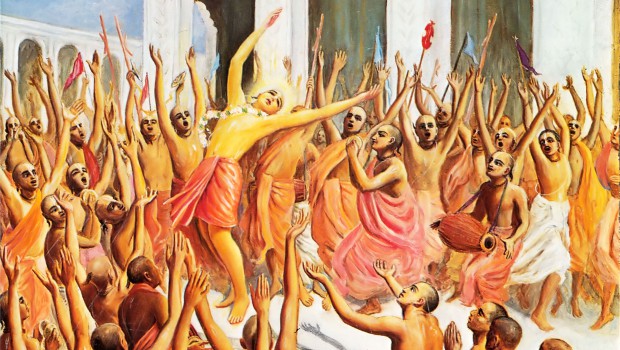
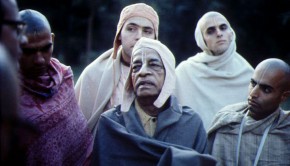
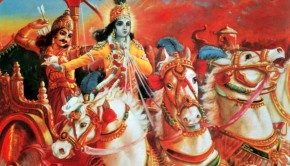
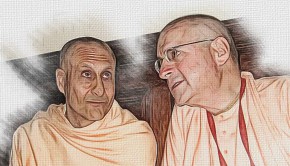
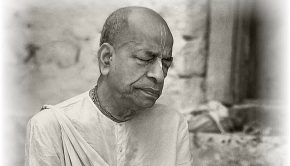









All glories to Srila Prabhupada
Hare Krishna
Just reading this gives me ecstasy 😉
LORD KRISNA IS THE MOST LOVABLE AND UNDERSTANDING,SUPREME BEING,KNOWER OF THE HEART,HELPING,GUIDING,TEACHING AS I HAVE PERSONALLY EXPERIENCED IN MY LIFE.WITHOUT HIS DIVINE GRACE I COULD NOT EVEN THINK OF LOVING HIM;FORGET OF SHEDDING TEARS FOR HIM WHEN I HEAR SONGS OF BHAKTI……….